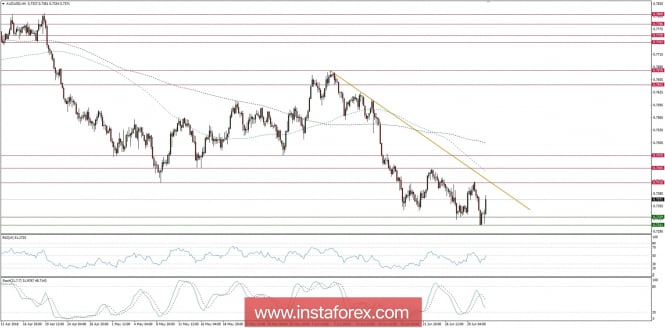Turbulence in the Chinese stock market and the yuan's sell-offs cover other topics and send a wave of pessimism through the global financial markets. USD/CNY remains at the center of attention, over 6.70 at night, at the most since August 2017. Concerns about the effects of the US-China trade war and the "contagion risk" on other Asian economies bring stock markets in Asia to 9 months lows. Japanese Nikkei225 is losing 0.6% today. Shanghai Composite at some point has been lowest for 28 months, although in the last minutes there are some attempts to recover.
During the night the situation was tried by the vice president of the PBOC who said that China has many tools to control the foreign exchange market, including extensive reserves. He is convinced that it will be possible to stabilize the course of the yuan because its foundations are solid and the economy is immune to shocks.
Pressure on EM currencies is less affected by the main pair. EUR/USD is holding close to 1.1640. The talks between German Chancellor Merkel and the Minister of Internal Affairs Horst Seehofer, who threatened his resignation yesterday, were helpful. The interviewees reached an agreement on migration issues, which diminishes the risk of the coalition breaking up.USD / JPY is still in opposition to signals from falling stock markets. During the night the course went to 111.10 but quickly dropped to 110.80.
On Tuesday 3rd of July, the event calendar is light in important data releases. The global investors will focus their attention only on Construction PMI data from the UK and RBC Manufacturing PMI (s.a.) from Canada.
AUD/USD analysis for 03/07/2018:
RBA has kept the interest rate at 1.50% in line with expectations. There were not many changes in the announcement. The bank maintains that low-interest rates help the economy and maintain the monetary policy in its current state will help maintain economic growth and allow inflation to return to the target. Previously, construction permits in Australia fell in May by 3.2 percent m/m with expectations of no change. In annual terms, the increase amounted to 3.3% with a 9.9% forecast.
In the Bank's opinion, low rates help the economy. The stable monetary policy is in line with economic growth and inflation. Business conditions are positive. Inflation will remain low for some time. In 2018, CPI inflation may be slightly above 2.0%.
The real estate market has slowed down in Sydney and Melbourne. The consumption of home businesses is still a source of uncertainty. Their revenues are growing slowly, and the level of indebtedness is high. The salary increase is still slow, it will probably continue for some time. The Australian dollar remains at the level maintained for the last few years, despite recent declines. We can be sure of one thing - the interest rate hike will not take place this year.
Let's now take a look at the AUD/USD technical picture at the H4 time frame. The pair was fairly stable around the night events, although in the last minutes the local low was made at the level of 0.7311 and now the price is trying to bounce towards the level of 0.7410. The market is still below the short-term trend line resistance and only a sustained breakout through it can change the bias from bearish to more bullish. Momentum remains around its fifty level but points to the upside. The next resistance levels are seen at 0.7445 and 0.7475.

